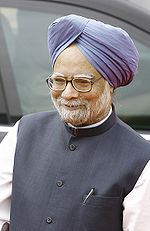- Nuclear Command Authority (India)
-
Nuclear Command Authority (India) Agency overview Formed 2003 Jurisdiction Indian government Headquarters New Delhi Employees Classified[citation needed] Annual budget Classified[citation needed] Agency executive Prime Minister Manmohan Singh The Nuclear Command Authority (NCA) of India is the nodal agency for all command, control and operational decisions regarding India's nuclear weapon stockpile.
Contents
Introduction
 Manmohan Singh is the current Prime minister of India and heads the NCA
Manmohan Singh is the current Prime minister of India and heads the NCA
India's first Nuclear test was conducted on 18 May 1974.[citation needed] Since then India has conducted another series of tests at the Pokhran test range in the state of Rajasthan in 1998, which included a thermonuclear test.[citation needed] India has an extensive civil and military nuclear program, which includes at least 10 nuclear reactors, uranium mining and milling sites, heavy water production facilities, a uranium enrichment plant, fuel fabrication facilities, and extensive nuclear research capabilities.[citation needed]
Though India has not made any official statements about the size of its nuclear arsenal, different estimates indicate that India has anywhere between 100 and 200 nuclear weapons[1][2]
On January 4, 2003, the Cabinet Committee on Security (CCS) constituted the Political Council and the Executive Council of the NCA.[citation needed] The Executive Council, chaired by National Security Advisor (NSA) gives the inputs to the Political Council, which authorises a nuclear attack when deemed necessary. The Political Council is chaired by the Prime Minister, and advised by the Executive Council, chaired by the NSA.[citation needed]
Their directives are to be operationalised by a new Strategic Forces Command under the control of a Commander-in-Chief of the rank of Air Marshal (or its equivalent) in charge of the management and administration of the tactical and strategic nuclear forces.
The NCA may be seen as the first stage in the development of an effective and robust Command and Control (C2) and Indications-and-Warning (I&W) systems and infrastructure for its strategic nuclear forces.
India is the first nuclear weapons country to have a no first use policy.
Delivery of weapons
- Main article: Indian nuclear weapon delivery systems
The current status of delivery systems for Indian nuclear weapons is unclear and highly classified. India has developed and tested nuclear weapons that could be delivered on the Prithvi and Agni missiles, although its extent and operational preparedness in this respect remains unclear. Since India probably had nuclear weapons prior to the availability of these missiles, it is probable that the current Indian nuclear weapons inventory includes weapons designed for delivery using aircraft. One or more of the following aircraft types might be used for this purpose. There are no open-source reports suggesting which if any of these aircraft have been equipped to deliver air-dropped atomic weapons. The MiG-27 and the Jaguar were originally designed to perform ground attack missions, and would require only modest modification to deliver nuclear weapons. The Indian Air Force also operates several other older and less capable types of ground-attack aircraft which would seem rather less likely candidates for delivering nuclear weapons. The MiG-29, Su-30 and Mirage 2000 were originally designed to perform air-to-air combat missions, though they could potentially be modified to deliver air-dropped nuclear weapons. Plans are also on for the delivery of nuclear weapons via the Advanced Technology Vessel using the SLBM/SLCM Sagarika.
New Delhi-Islamabad nuclear hotline
India and Pakistan set up their own nuclear hotline on Sunday, June 20, 2004.[3] The hotline was set up with the assistance of United States military officers.
References
- ^ Norris, Robert S. and Hans M. Kristensen. "India's nuclear forces, 2005," Bulletin of the Atomic Scientists 61:5 (September/October 2005): 73–75.
- ^ India's Nuclear Weapons Program - Present Capabilities
- ^ The Independent—Monday, June 21, 2004--"India and Pakistan to Have Nuclear Hotline":
See also
 Military of India Portal ·
Military of India Portal ·  Category (Army · Navy · Air Force · Coast Guard)
Category (Army · Navy · Air Force · Coast Guard)Branches History · Academies · Ranks and insignia:(Army · Air Force · Navy) · Special Forces · Indian Peace Keeping Force · Paramilitary forces · Strategic Forces Command · Strategic Nuclear Command · Ballistic missiles · Weapons of mass destruction · Defence Research and Development OrganisationWars and
conflictsIndo-Pakistani wars of 1947 / 1965 / 1971 · Operation Polo · Operation Vijay · Sino-Indian War · Chola incident · Siachen conflict · Blue Star · Woodrose · 1987 Sino-Indian skirmish · Indian intervention in the Sri Lankan Civil War · Operation Cactus · Kargil War · Kashmir insurgency · 2001 Indian–Bangladeshi border conflict · Operation Parakram · Piracy in SomaliaCategories:- Military of India
- Weapons of mass destruction
- Nuclear weapons programme of India
Wikimedia Foundation. 2010.
